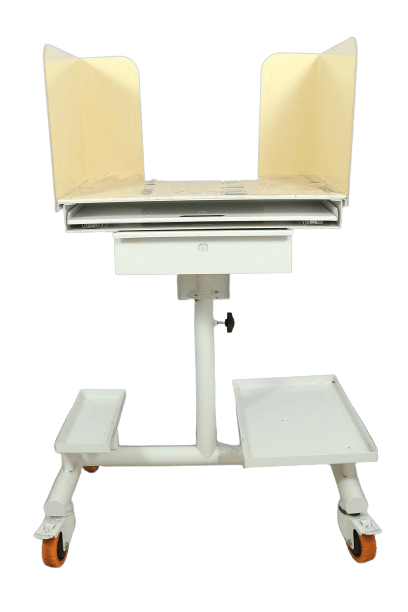Medical Trolley with Integrated Trolley Management System
In the fast-paced world of healthcare, keeping track of medical equipment, especially trolleys, is a real challenge. Hospitals often struggle with finding trolleys quickly, knowing their status, and ensuring they’re handled securely. This not only slows down daily operations but can also impact patient care and resource management.
Say hello to our game-changing solution – the Medical Trolley with Integrated Trolley Management System. It’s a carefully designed answer to the challenges healthcare providers face, promising a smooth and efficient workflow.
The magic happens with our trolley’s hardware component – it’s like the brains behind the operation. Using Wi-Fi, it tracks the trolley’s location, sensors provide real-time UPS charging updates, and smart mechanisms monitor its usage. The Android application is your user-friendly dashboard, offering real-time updates, alerts, and historical data for smart decision-making.
Our Medical Trolley is not your average cart – it’s a powerhouse with a built-in computer table, billing system, printer, and more. Doctors can access computers instantly for prescriptions, seamlessly integrating patient care into the system.
In a nutshell, our Medical Trolley with Integrated Trolley Management System is not just a product; it’s a game-changer for healthcare logistics. It ensures smooth operations, security, and smart decision-making. Step into the future of healthcare management – embrace our innovative solution today!
Features

Hardware Component
The hardware component installed within the trolley is responsible for gathering and transmitting essential data to the central system. This component consists of various sensors and communication modules that enable the following functionalities:
Trolley Location Tracking
The hardware component utilizes GPS or similar location-tracking technology to determine the precise location of the trolley. This location is tracked using Wi-Fi access point and information is relayed to the central system enabling real-time tracking and monitoring.
UPS charging status
The hardware component is equipped with sensors that detect whether the trolley is sufficiently charged or not. This data is transmitted to the central system, providing insights into the power status of the trolley.
Usage Tracking
By employing sensors or mechanisms to detect trolley movement or engagement, the hardware component can determine if the trolley is in use or idle. This data is vital for monitoring trolley utilization and optimizing operational efficiency.
Android Application
The Android application serves as the user interface for accessing and managing the trolley information collected by the Trolley Management System. Key features of the application include

Real-time Trolley Status
The application receives data from the central system and displays real-time information regarding the trolley's location, U.P.S charge status, and usage. This allows users to monitor the trolley's current state remotely.
Notification and Alerts
The Android application can send notifications and alerts to users based on predefined conditions or events. For example, it can notify users when a trolley is not sufficiently charged, when it enters or exits a specific area, or when it remains idle for an extended period.
Historical Data Analysis
The application provides access to historical trolley data, enabling users to analyze usage patterns, track performance metrics, and identify areas for improvement. This feature aids in making data-driven decisions and optimizing trolley management processes.
System Operation
- Data Collection
- User Access and Control
- Data Processing and Storage
- System Management and Administration
The hardware component installed within the trolley collects real-time data, including the trolley’s location, U.P.S charge status, and usage information. This data is transmitted to the central system through an internet connection.
Authorized users can access the Medical Trolley with Integrated Trolley Management System through the Android application. The application establishes a connection with the central system and retrieves the latest trolley information. Users can monitor the trolley’s location, U.P.S charge status, and usage, and receive relevant notifications and alerts.
The central system receives the data transmitted by the trolleys and processes it to generate meaningful insights. The system stores the collected data in a secure database for future analysis and retrieval.
The Medical Trolley with Integrated Trolley Management System includes an administrative interface accessible by authorized personnel. This interface allows administrators to configure system settings, manage user accounts and access privileges, generate reports, and perform other administrative tasks to ensure the smooth operation of the system.
Benefits and Applications
- Data-Driven Decision Making
- Improved Inventory Management
- Enhanced Security and Loss Prevention
- Efficient Trolley Tracking and Monitoring
The Medical Trolley with Integrated Trolley Management System generates comprehensive historical data that can be analyzed to identify trends, patterns, and performance metrics. This data-driven approach empowers organizations to make informed decisions, optimize processes, and improve overall operational efficiency.
By tracking trolley usage and movement, the system provides valuable insights into inventory flow. Organizations can analyze usage patterns, optimize stock placement, and streamline inventory management processes.
Real-time monitoring of trolley locations helps prevent theft, misplacement, or unauthorized movement of trolleys. The system can trigger alerts when a trolley deviates from a predefined path or leaves a designated area, enabling timely intervention and minimizing the risk of loss or damage.
The Medical Trolley with integrated Trolley Management System enables organizations to efficiently track and monitor the location, U.P.S charge status, and usage of medical trolleys. This information facilitates better resource allocation, reduces search time for trolleys, and improves overall operational efficiency.
